
|
Solar News 2008
January 2007 December · November · October · September · August · July · June · May · April · March · February · More... April 26, 2007 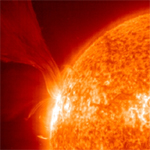 Solar peak expected in 2011-2012 (CNN.com) Scientists are predicting the next solar cycle will peak in 2011 or 2012. Increased solar activity may disrupt the Global Positioning System, airlines, and satellites. Image Credit: SOHO (ESA & NASA) April 25, 2007 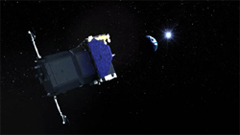 The Quest to Predict the Next Space "Hurricane" Season (NASA Feature) Violent solar events, like flares and coronal mass ejections, are the hurricanes of space weather, capable of causing havoc with satellites, power grids, and radio communication, including the Global Positioning System. Image Credit: NASA April 24, 2007 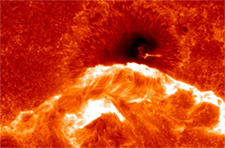 A Massive Explosion on the Sun (NASA Feature) Astronomers are calling the Japanese Hinode spacecraft a "Hubble for the sun." Watch this movie and you'll see why. The footage, gathered by Hinode's Solar Optical Telescope (SOT) on Dec. 13, 2006, shows sunspot 930 unleashing a powerful X-class solar flare. Image Credit: NASA April 23, 2007 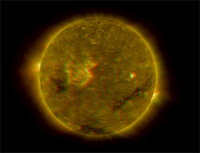 STEREO Sees the Sun in Three Dimensions (NASA Press Release) NASA's twin Solar Terrestrial Relations Observatory (STEREO) spacecraft have made the first three-dimensional images of the sun. The new view will greatly aid scientists’ ability to understand solar physics and thereby improve space weather forecasting. More Links: Image Credit: NASA/STEREO April 19, 2007 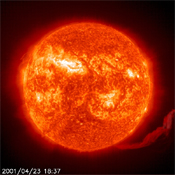
Sun's Atmosphere Sings (Yahoo! News) Astronomers have recorded heavenly music bellowed out by the Sun's atmosphere. Snagging orchestra seats for this solar symphony would be fruitless, however, as the frequency of the sound waves is below the human hearing threshold. While humans can make out sounds between 20 and 20,000 hertz, the solar sound waves are on the order of milli-hertz--a thousandth of a hertz. Image Credit: SOHO (ESA & NASA) April 4, 2007 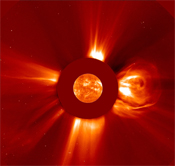 Solar bursts may threaten GPS (USA Today) Image Credit: NASA |